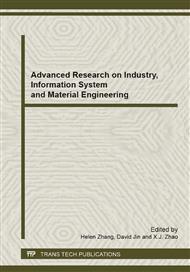[1]
Mills A, Le Hunte S. An overview of semiconductor photocatalysis[J]. Photoch Photobio A: Chemistry. 108(1): 1-35. (1997).
Google Scholar
[2]
Yi J H, Mo H M, Yi L H, et al. Research progress and application of TiO2 Modified with doped metal ions[J]. Technology and Development of Chemical Industry. 40(8): 35-38. (2011).
Google Scholar
[3]
Han Z X, Yin R, Li J Y, et al. Study on polyaniline-modified supported nano-titanium dioxide[J]. Inorganic Chemicals Industry. 12: 16-18. (2007).
Google Scholar
[4]
Christian L, Kunt H, Horst K, et al. Visible light photodegradation of 4-chlorophenol with a coke-containing titanium dioxide photocatalyst[J]. Applied Catalysis B: Environmental, 32: 215-227. (2001).
DOI: 10.1016/s0926-3373(01)00141-2
Google Scholar
[5]
Zhou L, Deng J, Zhao Y B, et al. Preparation and characterization of N-L Co-doped nanocrystal anatase TiO2 with enhanced photocatalytic activity under visible-light irradiation[J]. Mater Chenm Phys. 117(2-3): 522-527. (2009).
DOI: 10.1016/j.matchemphys.2009.06.036
Google Scholar
[6]
Guo G Q, Whitesell J K, Fox M A. Synthesis of TiO2 photocatalysts in supercritical CO2 via a nonhydrolytic route[J]. Phys. Chem. 109(40): 18781-18785. (2005).
DOI: 10.1021/jp0530101
Google Scholar
[7]
Liu S Y, Liu G C, Feng Q G. Al-doped TiO2 mesoporous materials: synthesis and odegradation photproperties[J]. Journal of Porous Materials. 17(2): 197-204. (2010).
Google Scholar
[8]
Xia Q B, Li Z, Xi H X. et al. Effects of Fe 3+ and Ce 3+ doping on photocatalytic performance of TiO2 photocatalysts[J]. Journal of Chemical Industry and Engineering. 56(9): 1666-1672. (2005).
Google Scholar
[9]
Yu J C, Zhang L Z, Zheng Z, et al. Synthesis and Characterization of Phosphated Mesoporous Titanium Dioxide with High Photocatalytic Activity[J]. Chem Mater. 15(11): 2280-2286. (2003).
DOI: 10.1021/cm0340781
Google Scholar
[10]
Jiang T Z, Liu S Y, Tang W H, et al. Synthesis of N and Al Co-doped TiO2 particles with visible light degradation property via solid state reaction route[J]. The Chinese Journal of Process Engineering. 11(2): 336-342. (2011).
Google Scholar
[11]
Khan R, Kim T J. Preparation and application of visible-lightresponsive Ni-doped and SnO2 -coupled TiO2 nanocom-posite photocatalysts[J]. Journal of Hazardous Materials. 163(2/3): 1179-1184. (2009).
DOI: 10.1016/j.jhazmat.2008.07.078
Google Scholar


